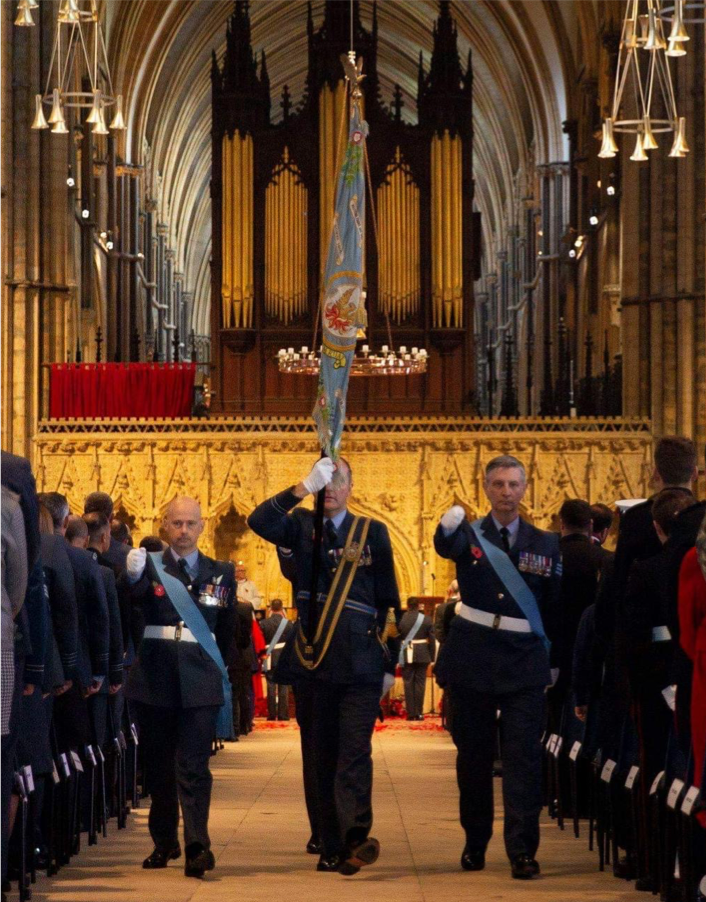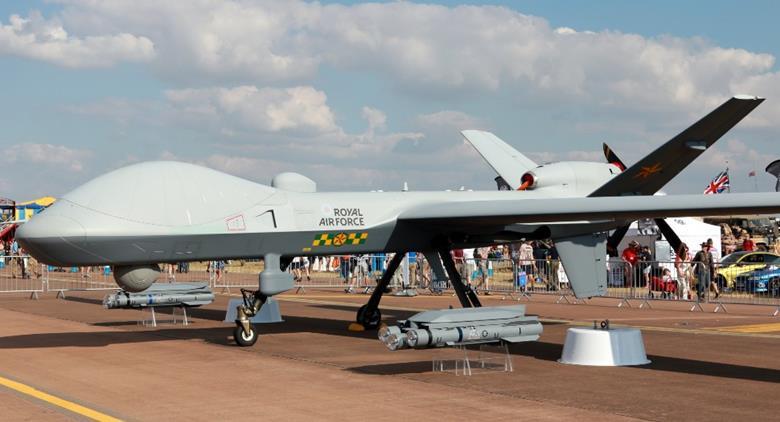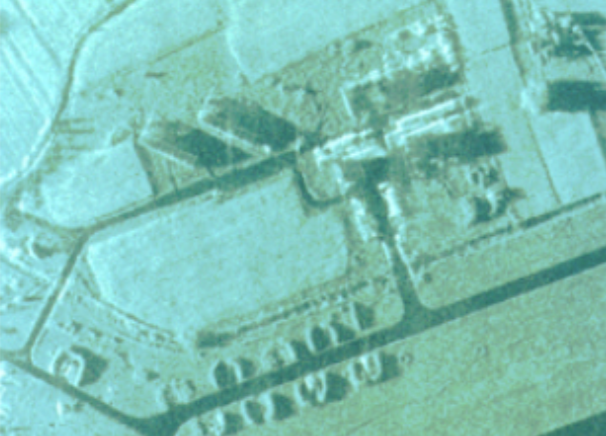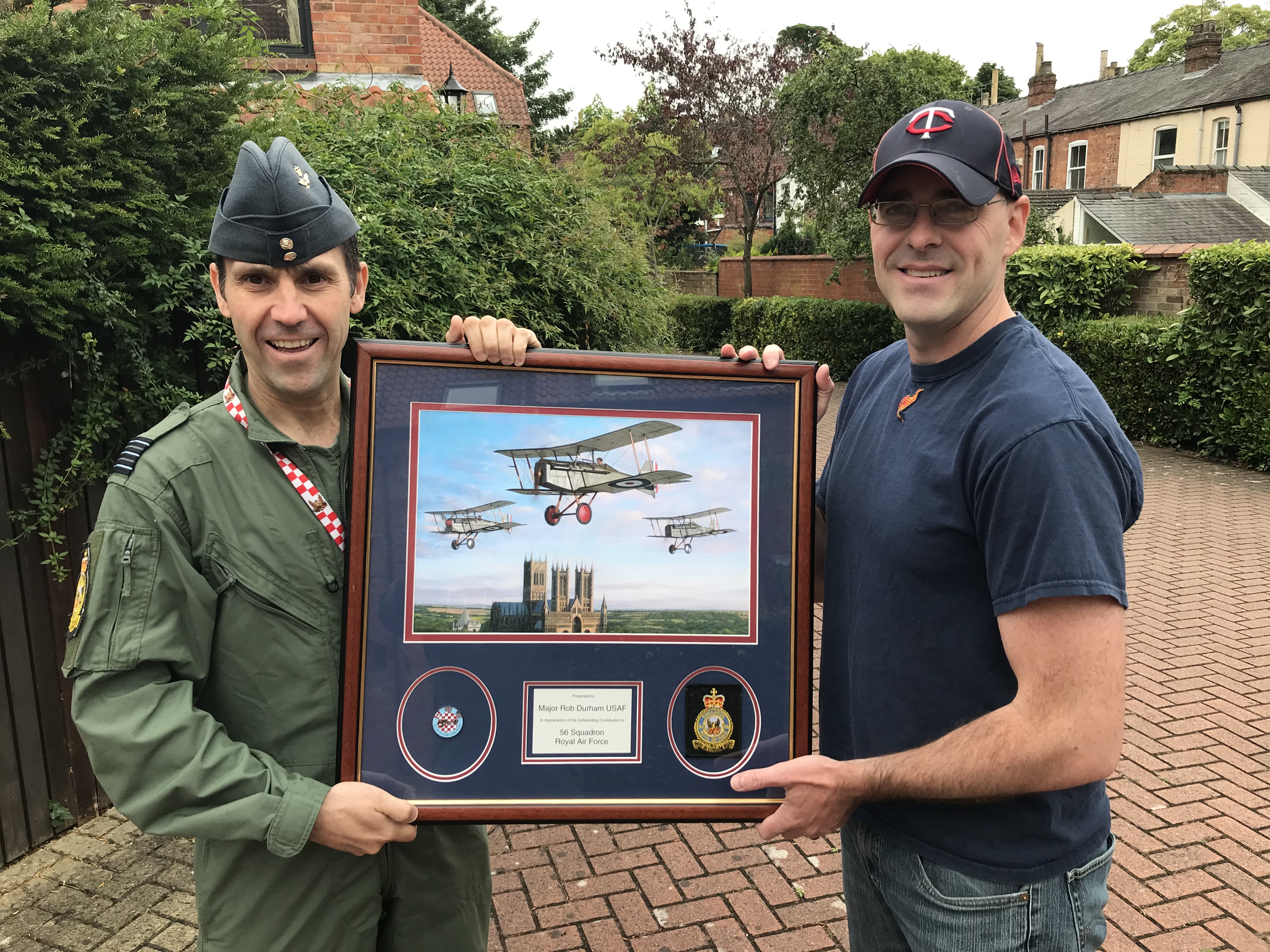 |
56 Air C2ISR T&E Squadron |
Squadron Newsletter - Jul 20 I hope this will be the first of a regular series of updates that you will receive from 56 Sqn. It comes at a time when many of you will be emerging from isolation and the Government enforced lockdown,imposed as a direct consequence of the COVID-19 pandemic. These are unprecedented times and the effects will undoubtedly reverberate for a considerable period as the RAF adjusts to our changing world. Events have however, provided me with an opportunity to reflect and I am extraordinarily keen to promote and develop the relationships we have with our Association. We are all privileged to have played our part in a sqn that enjoys such a rich and diverse heritage and one of my first objectives is to try to bring some of this diversity together, as I attempt to harness what we can learn and share with each other. Regretfully, we haven't got off to a good start and it is unfortunate that I was forced to cancel our inaugural Families' Day and Association dinner. As the Sqn Commander, I fully appreciate the importance of these events toward maintaining our 'esprit de corps'; however, considering the COVID-19 pandemic, safety was my paramount concern and despite our best intent, cancellation was the only option available to me. We will of course look to reconvene at a weekend adjacent to 8 Jun next year.
Like the entire UK, the pandemic has had a profound affect across Defence and, in a matter of days, completely changed how we work. Due to the vital role the Air & Space Warfare Centre (ASWC) performs in supporting global operations, the decision was quickly taken to protect those who are serving the front-line and reduce the Thomson Building (home of the ASWC and 56 Sqn) to minimum manning. Therefore, not long after assuming command, I found myself in the position of dispatching my personnel to work from their homes with a mixture of laptops, iPads and rapidly designed homeworking systems. We quickly identified our operationally critical work strands and prioritised our resources accordingly, ensuring that we continued to provide essential advice and assessment to the war fighter. Like many members of the Armed Forces, personnel from 56 Sqn were placed on high readiness to provide Military Aid to the Civil Authorities. Of course, this came at a time when many of the sqn were required to shield vulnerable members of their family, or to provide childcare and home schooling for their young families. It has been a challenging time for everybody.  One duty we were unable to continue was the Sqn’s ceremonial role at the various RAF and 56 Sqn events. For those from a non-flying background, representing a ‘numbered’ sqn at ceremonial events is often cited as one the highlights and privileges of their tour so this loss is keenly felt across the entire sqn. As soon as we can, I am determined that we will continue to exercise our freedom of Epping Forrest District and will proudly parade our Sqn Standard through the town of North Weald accordingly. I am pleased to say that we have now entered what could be termed as ‘steady state’, and we are largely returning to normal operations. We have resumed a wide variety of trials and activity across all our platforms and the sqn’s aircrew continue to support both routine and operational sorties across the entire ISTAR force. One element that has changed within the last year is that our force continues to grow and members of 56 Sqn have completed vital assessment work on the P-8A Poseidon MRA Mk1. This important work provided assurance and confidence to our Senior Leadership ofthe platform's suitability for operations,with our resultant output cited as being critical toward the declaration of Initial Operating Capability. I anticipate further changes as we look ahead with the inclusion of future Unmanned Air Systems, the introduction of E-7 Wedgetail and the continued evolution of Rivet Joint. I hope the following will give you a good insight into the how the sqn has changed from your time, and what it means to be a Firebird in 2020 and beyond. Intelligence and Space Exploitation Test & Evaluation FlightIt has been a considerably busy time for the Intelligence and Space Exploitation (ISX) TEF. There is much excitement with the new ISTAR platforms slowly coming into RAF service; especially the P-8A Poseidon MRA Mk1 and MQ-9B Protector. Both platforms possess significant ISTAR abilities which will keep the TEF busy for many years to come. Furthermore, the RAF is only just beginning the scratch the surface with what ISTAR accomplishments can be achieved with the F-35 Lightning II; an aircraft that is already pushing the Service towards the ‘Next Generation RAF’ envisioned by CAS. However, air platforms are only one aspect of what the ISX TEF gets involved with. You could even argue that the reach of the TEF is truly ‘out of this world’. Following the official adoption of Space by the RAF as part of its overall doctrine, the pace of change has accelerated. Space is now a recognised warfighting domain in its own right, and the RAF is placing considerable effort into making its mark alongside significant allied partners. CAS now holds an annual Air and Space Power Conference and the Air Warfare Centre has become the Air and Space Warfare Centre. It is within this rapidly changing environment that the ISX TEF now operates.  Ably led by Flt Lt Graham Gagg and supported by Sgt John Bell, the Space team may beone ofthe smallest on the sqn, but this doesn’t stop it having considerable reach and influence. Over the course of the last year, the team has provided expert advice on everything from satellite ground stations, sovereign UK satellite constellations, state of the art space Command and Control software and much more. The work truly indicates the level of effort and seriousness the RAF is putting towards generating a strong Space capability. As a centre of excellence, 56 Sqn is lucky to have two highly experienced Space experts. Growing the RAF’s awareness and understanding of the Space Domain will be a significant challenge. Just as every airman is taught to be ‘air-aware’, so too should we all become ‘space-aware’. The Space Domain is inescapable for military operations in the 21st Century. Both the Poseidon, Protector and Lightning aircraft (and many more besides), mentioned earlier would be severely impacted without access to Space services and the RAF must be able to defend that access. The future therefore is both an exciting and challenging one. As the ISX TEF boldly goes into a new era of the Next Generation RAF, it will be at the vanguard of how the Service wishes and needs to deliver that vision. Though there will almost certainly be challenges along the way, the ISX TEF will meet those challenges head on. Besides, all great adventures start with one small step... Airborne Electronic Surveillance Test & Evaluation FlightOn 31 Oct 19, a warm and humid autumn evening in Florida, a RAFAIR callsign radioed JAX approach for permission to land at the Naval Air Station Jacksonville. Precisely 3501 days since a Nimrod MR2 called Kinloss approach for the last time, the first new RAF Maritime Patrol Aircraft was being delivered into the UK inventory. The Poseidon MRA Mk1 was procured through a Foreign Military Sales purchase from the United States Navy. The RAF is to receive nine of these aircraft and it will complement the platforms already in service with our allies in the USA and Australia. Subsequent orders have also been placed by Norway and New Zealand and the future holds some excellent opportunities for collaboration and mutual training. The Poseidon, built by Boeing, is a variation of the hugely successful 737 Next Generation (NG) with a737-800 fuselage mated to 737-900 wings and is HQ 1 Group’s newest addition into the ISTAR fleet.  It has been a long time in the making, but with the arrival of Poseidon, 56 Sqn’s, Maritime Team were tasked to conduct Test and Evaluation (T&E) as part of the acceptance work required to accept the aircraft into RAF service. Working closely with the Air Capability Delivery Programme team and the recently re-formed No 120 Sqn, the pressure was on to carry out the necessary trials work; the evidence of which would be used by the Programme Sponsor to inform the IOC declaration on 1 Apr 20. 56 Sqn had been tasked with performing an assessment of both the Anti-Submarine and Anti-Surface Unit capabilities of the platform in order to support the declaration and the Maritime team remained at NAS Jacksonville until Feb 20 when aircraft ZP 801, ‘The Pride of Moray’ returned to the UK. This activity culminated in the publication of the 56 Sqn Poseidon trial report which was used as part of the Acceptance Case Report for the declaration of IOC on 1 Apr 20. However, there will be no let-up in activity as the next Poseidon capability milestone, Interim Capability, is Sep 21 and the Maritime team are already preparing and planning future T&E activities to support this next important programme milestone. Tactical ISR Test & Evaluation FlightEnsuring that 56 Sqn maintains its place at the forefront of the RAF’s capabilities, the s qn is starting to focus its attention on the MQ-9B Protector RG Mk1, the UK’s new Medium Altitude Long Endurance (MALE) Remotely Piloted Aircraft System (RPAS) which is due to replace the UK MQ-9A Reaper from 2022. Protector promises to be a step change in capability from Reaper, with a wider mission set, significantly longer endurance, and a cutting - edge sensor suite. The Protector system is based around General Atomics' Sky Guardian baseline air vehicle platform which has a wingspan of 79 ft (more than double that of the Typhoon’s 36 ft), a redesigned Ground Control Station, and a range of additional UK sovereign capabilities. It will also be the first RAF Unmanned Aerial Vehicle to be certified for flight in non-segregated airspace (and therefore able to operate directly from UK military airfields) owing to its Detect and Avoid capabilities.  Unlike MQ-9 Reaper, Protector is due to be equipped with a UK sovereign weapons loadout including Raytheon's Paveway IV laser-guided bomb and MBDA's Brimstone precision laser-guided missile. The programme is currently advancing well through the development phase, with an RAF Combined Test Team co - located with and working alongside General Atomics in the USA conducting the traditional Developmental T&E . However, 56 Sqn are starting to consider the programme's Operational T&E requirements and developing a plan to manage the vast amount of work that this range of new capabilities will bring, once the aircraft and its supported systems arrive at RAF Waddington in 2022. Our current one-man Protector element is shortly due to grow to 2 full crews (each crew consisting of a Pilot, Sensor Operator and a Mission Intelligence Coordinator), with a planned OCU date for both crews of early 2022, alongside the first cadre of frontline instructors Wide Area Surveillance Test & Evaluation FlightOn the 31 Mar 21, after distinguished operational service, the RAF’s Sentinel R Mk1 aircraft will retire from service. Based on the Bombardier Global Express business jet, this will be perhaps one of the few occasions when an aircraft is retired despite the relative youth of the airframe and with plenty of flying hours remaining. The mission system however required a technical refresh and in these difficult financial times, Defence had to make a cost/benefit decision whether to invest in the platform for another 10 to 15 years.  Sentinel entered service with V(AC) Sqn in 2008 and immediately deployed on operations, flying its first ops mission in November of that year. At that time the system was known as ASTOR (Airborne Stand-Off Radar), with a concept of operations based around the aircraft downlinking radar imagery data to an array of tactical and operation ground stations. These were either 6x6 Pinzgauer vehicles and trailers at the tactical level or container-based cabins at the operational level. At this early stage,T&E was critical to the acceptance and development of this cutting-edge technology. It is worthy of note that this was a brand-new capability for the Armed Forces, borne out of the 1980s and an identified need for all-weather, day/night, wide area battlefield reconnaissance. 56 Sqn’s involvement precedes the front-line delivery with members of the then ASTOR Test and Evaluation Flt making frequent trips to the contactor site at Greenville Texas to advise the procurement team on deliverable milestones. Such was the diversity of skills needed at that time, the team amounted to 8 officers and SNCOs including RAF Navigators and Non-Commissioned Aircrew, Int Corps Officers and Image Analysts, REME Technicians and RAF Trade Group 11 Intelligence Analysts.  Surviving 2 Strategic Defence and Security Reviews, Sentinel’s future was always in the balance with an out of service date of 2015 being moved to 2018 and finally 2021. During this time the ground element was disbanded, and off-tether operations became the norm. This put enormous strain on the mission crew of 3; to conduct all near real-time, on-board analysis of the collected Synthetic Aperture and Ground Moving Target Indicator modes of the radar (SAR/GMTI), while communicating with tactical and strategic air assets and ground units in the theatre of operations. At the same time the trials team, now rebranded as the AGS TEF lost much of its personnel leaving a qualified Airborne Mission Commander (AMC) and Airborne Image Analyst (AIA) to carry on the fight. However, far from stifling development, this reduction in manpower together with a lack of long-term investment made the platform ripe for low cost innovation. So, in the tradition of 56 Sqn reminiscent of the novel ideas of McCudden and Ball, the TEF brought many developments to the FL. These included maritime characterisation of the radar, off-board Chat via Satellite Communications, software upgrades to enhance mission planning and execution and tools to aid interoperability with NATO allies. One of the key achievements was that of an advanced change detection algorithm using the radar in its Synthetic Aperture mode. For this work and the contribution, the resultant capability made to operations, the TEF was awarded a Chief of Staff (Operations) team commendation in the 2013 New Year Honours list. In the lead up to out of service date the team continue to work on trials activity with an assessment of a newly introduced update to the SatCom Chat facility, which will allow Sentinel to communicate with NATO AGS. This will provide a UK contribution in kind to this newly established NATO fleet of Global Hawk UAS providing a similar shared capability to all NATO nations. It is therefore fitting, or possibly ironic, that this will be the last Sentinel trial for 56 Sqn.  Aerospace Battle Managers Test & Evaluation FlightThe Aerospace Battle Management (ABM) TEFhasbeen committed to trialling and developing the Air Force's Counter Unmanned Aerial System (C-UAS) solution for the past 2 years. As the project gathers pace, the Air Capability Development Office are looking atadding a 'hard-kill' option into the arsenal of the C-UAS suite. This has resulted in an exciting trial into OpenWorks Engineering's SkyWall Auto system - an autonomous drone net-capture system SkyWall Auto launches a projectile, using air pressure, upto the target drone after the system has autonomously acquired and tracked it using world leading edge artificial intelligence technology. From the projectile, a net is deployed which envelopes the target drone and brings it safely back to the ground under a parachute. The system can be permanently installed on a building or vehicle mounted for a mobile deployment. Once captured, the drone can be safely recovered and exploited therefore increasing the chance of a successful prosecution. The 2-week trial was delivered by members of the ABM TEF at Stocksfield, Northumberland. The trial put the system through its paces, assessing SkyWall Auto's ability to successfully engage targets at varying speeds, heights and distances. The data gathered and analysed will be used to determine whether SkyWall Auto is a suitable addition to the RAFs C-UAS solution. If deemed a viable option then further trials will be planned to fully integrate SkyWall Auto into the existing RAF C-UAS suite.
Ceremonial DutiesFollowing on from the celebrations throughout 2018 that marked the RAF’s Centenary year and the bestowing of the ‘Freedom of Epping Forest District’ upon 56 Sqn, 2019 was always going to be a quieter period and one of reflection. In Sep19, 56 Sqn were delighted to be able to parade their Standard at the North Weald Battle of Britain Service. This is of great significance to the Sqn as North Weald is the spiritual home of 56 Sqn having been based there from 1927 until 1941. It also gave the new OC the opportunity to meet members of the Epping Forest District Council and have a tour of the North Weald Airfield and Museum. The Sqn also supported Remembrance Sunday events in two locations, Lincoln and North Weald. Whilst the Standard wasn’t paraded, personnel attended Services and 56 Sqn XO, Sqn Ldr Spud Harrild, laid a wreath at the North Weald memorial. 2020 marks the 80th Anniversary of the Battle of Britain and several events were planned to commemorate this milestone. How many of these survive COVID-19 is a different matter, however the major event we are all hoping still occurs is the Battle of Britain Service at Westminster Abbey in Sep20.
Farewells Despite the pandemic causing a temporary halt on all postings and assignments for UK defence personnel, this obviously didn’t apply to our exchange officers. We recently bid farewell to Major Rob Durham, USAF who has been recalled to the US to attend Staff College at Maxwell AFB, Alabama. Throughout his time on 56 Sqn, Rob was a valued and well-respected member of the Rivet Joint team, who brought a wealth of knowledge and experience from the USAF Rivet Joint Force. His time on 56 Sqn was cut short due to his recall to Staff College and his presence on the team and in the office will be sorely missed. We know that Rob, Anna and the boys greatly enjoyed their time in Lincolnshire and in the UK and we wish them a safe trip back to the US and the best of luck at Staff College and for the future. It’s fair to say that like most of the UK, the COVID-19 has had a profound affect across Defence and 56 Sqn. However, I hope this newsletter demonstrates that in the best traditions of the Sqn, the modern-day Phoenixes have risen above the pandemic and continue our core activity; supporting the frontline with sound technical advice and well planned and executed trials activity. I hope you all remain safe and look forward to when we can next be together to celebrate the ethos of the Sqn at next year’s Association dinner.
Dave Smathers Note: Images taken from raf.mod.uk website and 56 Squadron archives, UK Crown copyright. Last update 27th July 2020. |